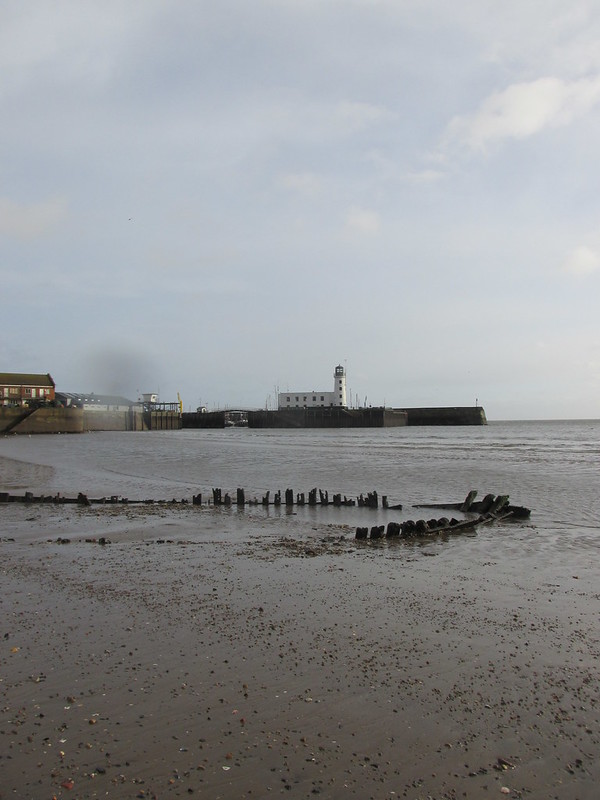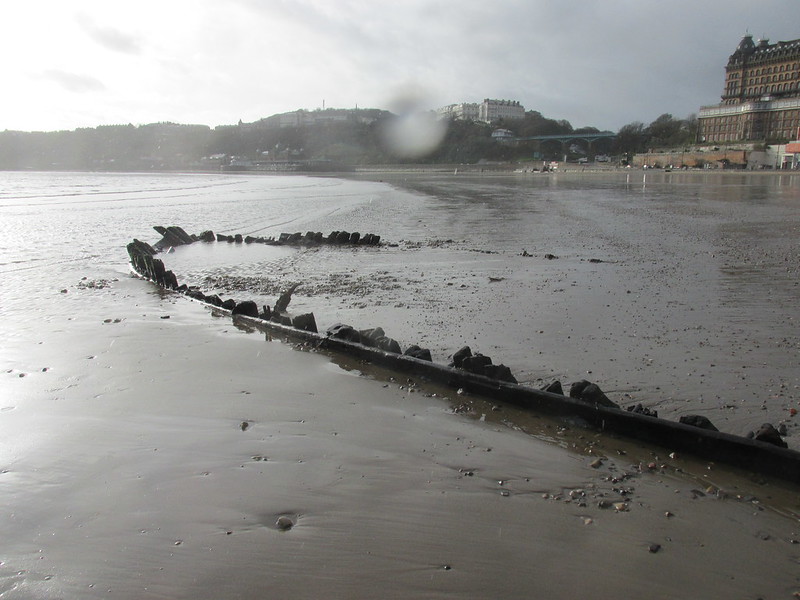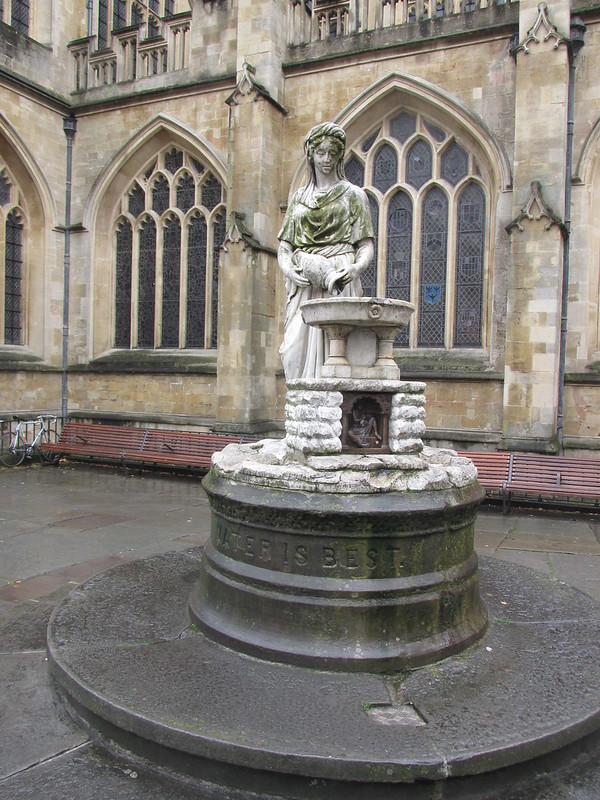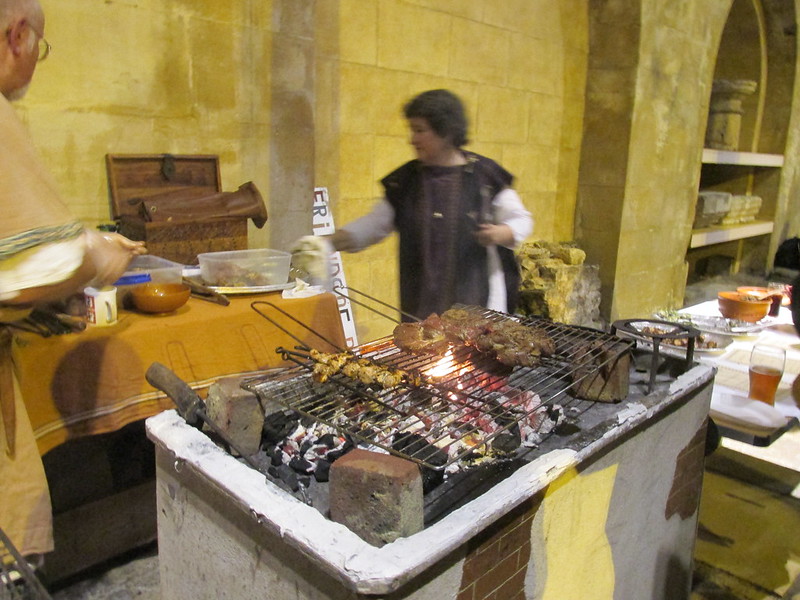This weekend we were lucky enough to see something in Scarborough that's not always on show. Weather and tide conditions shift the sands on the south bay and once in a while the ribs of a wrecked boat appear for a few days.
No-one is really sure what the boat is. A report by the Scarborough Maritime Heritage Centre offers some possibilities.
One suggestion is that it could be the remains of the Coupland, which sank in 1861, also leading to the wreck of the town's lifeboat Amelia. But the Coupland is supposed to have foundered on rocks near the spa, and would have been smashed to pieces.
Another theory was that the boat was the Arun, which went down in storms in 1880, but according to historian George Westwood the wreck in the beach isn't big enough to be the Arun. Westwood believes the wreck is the Vivid, which sank while entering the harbour in 1888.
Whatever it is, this weekend was the first time I've ever seen the wreck, in spite of being associated with the town, and a regular visitor, for 50 plus years. It made my weekend!
(Please excuse the raindrops on the lens!)
Sunday, 29 November 2015
Friday, 20 November 2015
Water is Best
Water is Best according to a sweet little marble statue erected near the Abbey by the Bath Temperance Association. The Association was founded in 1836 and preached the evils of drink to the townspeople. The cute girl and her jug were put in place in 1861.
Wednesday, 11 November 2015
Try a Roman recipe
As I mentioned in my last post we had chance to try authentic Roman food during our trip to the baths in Bath. It was prepared mostly in kebab-style, and the food historian Sally Grainger (you might have seen her on Time Team) cooked it on a huge barbecue.
I tried to follow her chicken recipe last weekend and it came out remarkably well, though I fried it in olive oil, rather than barbecuing. Grilling would also work.
No quantities, I'm afraid, that was the Roman way. Flavour to taste.
PULLUM IN IVRE CRUDO
Marinate pieces of chicken in:
mustard, dill, mint, wine, vinegar, olive oil, and fish sauce*.
Grill, and serve in flatbreads or pitta breads with shredded green salad and a good olive tapenade.
*"Fish sauce" was a ubiquitous Roman ingredient shipped all around the known world in amphorae and used to flavour practically everything they ate. It was like a sloppy Gentleman's Relish and a bit of that mixed into your marinade would be fine. I used two salted anchovies. Don't be too tied down by the rules. Improvise!
I tried to follow her chicken recipe last weekend and it came out remarkably well, though I fried it in olive oil, rather than barbecuing. Grilling would also work.
No quantities, I'm afraid, that was the Roman way. Flavour to taste.
PULLUM IN IVRE CRUDO
Marinate pieces of chicken in:
mustard, dill, mint, wine, vinegar, olive oil, and fish sauce*.
Grill, and serve in flatbreads or pitta breads with shredded green salad and a good olive tapenade.
*"Fish sauce" was a ubiquitous Roman ingredient shipped all around the known world in amphorae and used to flavour practically everything they ate. It was like a sloppy Gentleman's Relish and a bit of that mixed into your marinade would be fine. I used two salted anchovies. Don't be too tied down by the rules. Improvise!
Sunday, 8 November 2015
Baths in Bath
The hot baths in Bath (Aquae Sulis) was one of the largest and most luxurious leisure sites in the ancient Roman world. The naturally hot spring allowed the bath itself to be bigger than anything it was possible to construct over artificial heat. Romans built constructions called hypocausts to act as underfloor heating in bath houses.
They consist of piles of tile-like bricks that support the floor, but allow the flow of hot air from a furnace to pass underneath. Bath has one that warmed the steam room, but didn't need one to heat the bath itself, because the water comes out of the ground at 46 degrees centigrade - a nice, warm bath!
It flowed up from the ground in an area now known as the sacred spring, then was diverted into the bath itself. As well as the bath there were various other rooms including hot dry rooms, like a modern sauna, steam rooms, places for massage, cold pools to cool off in, and it's likely there were places to buy food and drink as well.
Next door to the baths complex was a temple to the goddess Sulis, a Celtic deity who was celebrated on the site before the Romans arrived. Her identity was joined to the Roman goddess Minerva so the temple was dedicated to one figure representing both. A life-sized statue stood in the temple, but all that remains today is her head.
During our recent trip to Bath we were lucky enough to take part in a Museums at Night Week event where we tried authentic Roman food while sitting around the edge of the baths, which were lit with torches, rather than electricity.
The whole complex had an eerie feel to it as a result, which added enormously to the authenticity. It's £14 a head to get in, which feels slightly expensive, but it's worth every penny. If you're in the area, do make an effort to go and see it.
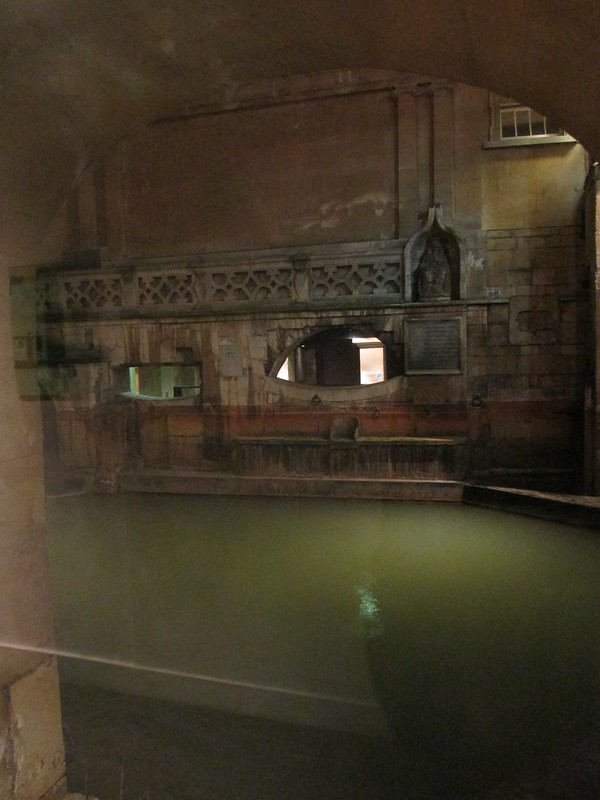 |
| The Sacred Spring |
It flowed up from the ground in an area now known as the sacred spring, then was diverted into the bath itself. As well as the bath there were various other rooms including hot dry rooms, like a modern sauna, steam rooms, places for massage, cold pools to cool off in, and it's likely there were places to buy food and drink as well.
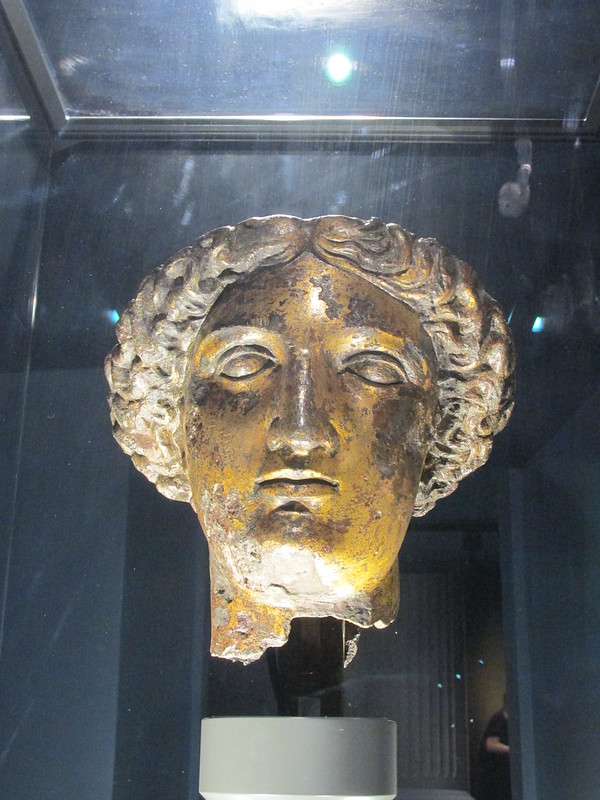 |
| Minerva Sulis - Goddess of the waters |
During our recent trip to Bath we were lucky enough to take part in a Museums at Night Week event where we tried authentic Roman food while sitting around the edge of the baths, which were lit with torches, rather than electricity.
The whole complex had an eerie feel to it as a result, which added enormously to the authenticity. It's £14 a head to get in, which feels slightly expensive, but it's worth every penny. If you're in the area, do make an effort to go and see it.
Subscribe to:
Posts (Atom)

